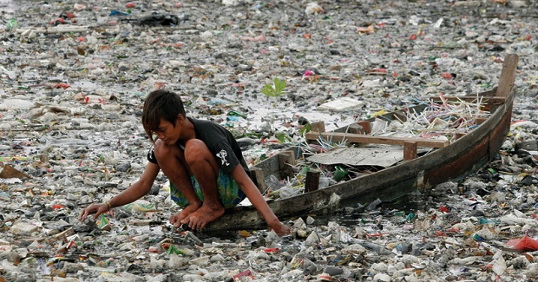1 March 31, 2016
Relevant Topic
1. Le Hung Trinh
Application of Remote Sensing for Monitoring of Subsurface Coal Fire: a Case Study in Khanh Hoa Coal Mine, Thai Nguyen Province, Vietnam
International Journal of Environmental Problems, 2016, Vol. (3), Is. 1, pp. 4-13.
Number of views: 2263 Download in PDF
International Journal of Environmental Problems, 2016, Vol. (3), Is. 1, pp. 4-13.
Abstract:
The Khanh Hoa coal mine is a surface coal mine in the Thai Nguyen province, which is one of the largest deposits of coal in the Vietnam. In recent years due to many reasons such as backward mining techniques and unauthorized mining caused subsurface coal fire in this area. Coal fire is a dangerous phenomenon which seriously affects the environment by releasing toxic fumes, causes forest fires and subsidence of infrastructure surface. This article presents study on the application of LANDSAT multi – temporal thermal infrared images, which help to detect coal fire. The results obtained in this study can be used to monitor fire zones so as to give warnings and solutions to prevent coal fire.
The Khanh Hoa coal mine is a surface coal mine in the Thai Nguyen province, which is one of the largest deposits of coal in the Vietnam. In recent years due to many reasons such as backward mining techniques and unauthorized mining caused subsurface coal fire in this area. Coal fire is a dangerous phenomenon which seriously affects the environment by releasing toxic fumes, causes forest fires and subsidence of infrastructure surface. This article presents study on the application of LANDSAT multi – temporal thermal infrared images, which help to detect coal fire. The results obtained in this study can be used to monitor fire zones so as to give warnings and solutions to prevent coal fire.
Number of views: 2263 Download in PDF
The Science and the Problems of Development
2. Valentin T. Cheshko, Valery I. Glazko
Сo-evolutionary biosemantics of evolutionary risk at technogenic civilization: Hiroshima, Chernobyl – Fukushima and further…
International Journal of Environmental Problems, 2016, Vol. (3), Is. 1, pp. 14-25.
Number of views: 2200 Download in PDF
International Journal of Environmental Problems, 2016, Vol. (3), Is. 1, pp. 14-25.
Abstract:
From Chernobyl to Fukushima, it became clear that the technology is a system evolutionary factor, and the consequences of man-made disasters, as the actualization of risk related to changes in the social heredity (cultural transmission) elements. The uniqueness of the human phenomenon is a characteristic of the system arising out of the nonlinear interaction of biological, cultural and techno-rationalistic adaptive modules. Distribution emerging adaptive innovation within each module is in accordance with the two algorithms that are characterized by the dominance of vertical (transgenerational) and horizontal (infection, contagion) adaptive streams of information, respectively. Evolutionary risk is the result of an imbalance of autonomous adaptive systems have an essential attribute of adaptibe strategy of Homo. Technological civilization inherent predisposition to overcome their dependence on biological and physical components. This feature serves as an enhancer of the evolutionary generating conjugate with the scientific and technological development risk We can assume the existence of an intention of Western mentality to a high priority (positive or negative) of technological modifications micro-social environment and post-Soviet (East Slavic) mentality to modification of macro-social system.
From Chernobyl to Fukushima, it became clear that the technology is a system evolutionary factor, and the consequences of man-made disasters, as the actualization of risk related to changes in the social heredity (cultural transmission) elements. The uniqueness of the human phenomenon is a characteristic of the system arising out of the nonlinear interaction of biological, cultural and techno-rationalistic adaptive modules. Distribution emerging adaptive innovation within each module is in accordance with the two algorithms that are characterized by the dominance of vertical (transgenerational) and horizontal (infection, contagion) adaptive streams of information, respectively. Evolutionary risk is the result of an imbalance of autonomous adaptive systems have an essential attribute of adaptibe strategy of Homo. Technological civilization inherent predisposition to overcome their dependence on biological and physical components. This feature serves as an enhancer of the evolutionary generating conjugate with the scientific and technological development risk We can assume the existence of an intention of Western mentality to a high priority (positive or negative) of technological modifications micro-social environment and post-Soviet (East Slavic) mentality to modification of macro-social system.
Number of views: 2200 Download in PDF
Articles and Statements
3. Vyacheslav S. Anisimov, Natalia I. Sanzharova, Rudolph M. Alexakhin
137Cs behavior in the system soil – plant in the stationary sampling sites located within the 30-kilometer zone of the Chernobyl NPP in the period 1987-1992: II. Vertical migration in soils and accumulation of 137Cs in natural meadow grasses
International Journal of Environmental Problems, 2016, Vol. (3), Is. 1, pp. 26-57.
Number of views: 2291 Download in PDF
4. Valery P. KalinitchenkoInternational Journal of Environmental Problems, 2016, Vol. (3), Is. 1, pp. 26-57.
Abstract:
It was shown that on the territory of 30-km area around the Chernobyl nuclear power plant highlighted 2 zones, which differ in the form of depositions of radionuclides. The first, which was called the "near" zone, dominated by the fuel component; the second, named "remote" zone, dominated by the condensation component. In the "near" to the reactor zone properties of 137Cs were largely determined by the occurrence of the radionuclide within transformed fuel particles and composite reactor’s materials (primarily, graphite) besides o SAC (soil adsorbtion complex). The radiocesium incorpoprated in composition of graphite particles, during the entire period of study (1986-1992) have been gradually leaching out of them, while remaining readily available for plant uptake. At the same time, most of 137Cs located in SAC, due to irreversible fixation by clay minerals of the soil became inaccessible for plants. As a result, during the period of research the mobility of radiocaesium in the system "soil-plant" was higher in "near" to the reactor zone, than in "remote" with a predominance of condensation forms of the radioactive fallout: the transfer factors (TF) of 137Cs in "near" zone, in average, turned out in 1988 to 1.6 in 1989 to 2.4 in 1990 to 3.1, and in 1992 to 4.0 times higher than in "remote" zone. In lysimetric waters collected at sites with a predominance of the fuel components of the radioactive fallout, there was marked increased 137Cs volume activity. Nevertheless, in the soil of the area located in the "near" zone, the content of the exchange form of the radionuclide was 2.5-7 times less in comparison with other plots, located in the "remote" zone. This may be due to the transition of 137Cs in the lysimetric water by leaching from graphite particles and transformed nuclear fuel. However, in the whole, the concentrations of 137Cs in the lysimetric waters have been negligible, which have lead to the very slight removal of radionuclide from the upper layers of the soils with the help of gravitational current of moisture. So, outside the layer 0-2 cm of soils for both "near" and "remote" zones with the help of gravitational moisture current during the growing seasons in 19 and in the 1990's, there were removed, respectively, rom 1.1×10-2 to 6.0×10-2 % and rom 6.0×10-3 to 2.6×10-2 % of the total 137Cs content in the layer. The main factor influencing the uptake of 137Cs by plants within a 30-km zone around ChNPP, as revealed by the research results, was a deposition form of the radionuclide. Next, in order of decreasing influence are following: type of soil water regime, then follow the agro-chemical and physical properties of soil (in order of decreasing the influence on radiocaesium uptake by plants: pH, the content of mobile forms of phosphorus, manganese, potassium, CEC). Uptake of 137Cs in natural grass herbage decreases over time exponentially. Periods of half-decreasing of 137Cs accumulation by plants, from 1987 to 1992, ranging between 2.1-7.3 years for automorphous and hydromorphous soils of "near" and "remote" zones. Experimental data on vertical distribution of 137Cs in the soils of permanent sample sites were processed using two-component quasi-diffusion model of the radionuclide migration in the soil. As a result, the calculated effective half-reducing periods of the radionuclide from the layer 0-5 cm ranged from 18.8 to 27.7 years, from the layer 0-10 cm from 27.3 years to 30.1 years. Environmental half-reducing periods of radiocesium (not taking into account the process of radioactive decay), differed for hydromorphous and associated automorphous soils. For hydromorphous soils, a period for the layer 0-5 cm 172-461, 0-10 cm – 282-758 years. For automorphous soils the relevant periods is 393-763 and 646-1253 years respectively.
It was shown that on the territory of 30-km area around the Chernobyl nuclear power plant highlighted 2 zones, which differ in the form of depositions of radionuclides. The first, which was called the "near" zone, dominated by the fuel component; the second, named "remote" zone, dominated by the condensation component. In the "near" to the reactor zone properties of 137Cs were largely determined by the occurrence of the radionuclide within transformed fuel particles and composite reactor’s materials (primarily, graphite) besides o SAC (soil adsorbtion complex). The radiocesium incorpoprated in composition of graphite particles, during the entire period of study (1986-1992) have been gradually leaching out of them, while remaining readily available for plant uptake. At the same time, most of 137Cs located in SAC, due to irreversible fixation by clay minerals of the soil became inaccessible for plants. As a result, during the period of research the mobility of radiocaesium in the system "soil-plant" was higher in "near" to the reactor zone, than in "remote" with a predominance of condensation forms of the radioactive fallout: the transfer factors (TF) of 137Cs in "near" zone, in average, turned out in 1988 to 1.6 in 1989 to 2.4 in 1990 to 3.1, and in 1992 to 4.0 times higher than in "remote" zone. In lysimetric waters collected at sites with a predominance of the fuel components of the radioactive fallout, there was marked increased 137Cs volume activity. Nevertheless, in the soil of the area located in the "near" zone, the content of the exchange form of the radionuclide was 2.5-7 times less in comparison with other plots, located in the "remote" zone. This may be due to the transition of 137Cs in the lysimetric water by leaching from graphite particles and transformed nuclear fuel. However, in the whole, the concentrations of 137Cs in the lysimetric waters have been negligible, which have lead to the very slight removal of radionuclide from the upper layers of the soils with the help of gravitational current of moisture. So, outside the layer 0-2 cm of soils for both "near" and "remote" zones with the help of gravitational moisture current during the growing seasons in 19 and in the 1990's, there were removed, respectively, rom 1.1×10-2 to 6.0×10-2 % and rom 6.0×10-3 to 2.6×10-2 % of the total 137Cs content in the layer. The main factor influencing the uptake of 137Cs by plants within a 30-km zone around ChNPP, as revealed by the research results, was a deposition form of the radionuclide. Next, in order of decreasing influence are following: type of soil water regime, then follow the agro-chemical and physical properties of soil (in order of decreasing the influence on radiocaesium uptake by plants: pH, the content of mobile forms of phosphorus, manganese, potassium, CEC). Uptake of 137Cs in natural grass herbage decreases over time exponentially. Periods of half-decreasing of 137Cs accumulation by plants, from 1987 to 1992, ranging between 2.1-7.3 years for automorphous and hydromorphous soils of "near" and "remote" zones. Experimental data on vertical distribution of 137Cs in the soils of permanent sample sites were processed using two-component quasi-diffusion model of the radionuclide migration in the soil. As a result, the calculated effective half-reducing periods of the radionuclide from the layer 0-5 cm ranged from 18.8 to 27.7 years, from the layer 0-10 cm from 27.3 years to 30.1 years. Environmental half-reducing periods of radiocesium (not taking into account the process of radioactive decay), differed for hydromorphous and associated automorphous soils. For hydromorphous soils, a period for the layer 0-5 cm 172-461, 0-10 cm – 282-758 years. For automorphous soils the relevant periods is 393-763 and 646-1253 years respectively.
Number of views: 2291 Download in PDF
Technologies and Technical Means for Matter Recycling into the Soil (Review)
International Journal of Environmental Problems, 2016, Vol. (3), Is. 1, pp. 58-85.
Number of views: 2792 Download in PDF
5. International Journal of Environmental Problems, 2016, Vol. (3), Is. 1, pp. 58-85.
Abstract:
The conflict of biosphere and technology requires changed development paradigm, promotes the nature-similar technologies. The soils of agricultural lands are compacted, alkaline, acid, lose humus and nutrients. Geochemical cycle of matter in the soil is open, the material is leached and resides predominantly in deposits that due to the limited resources of the Earth leads to the extinction of the biosphere. The eluvial-illuvial soil evolution vector is unfavorable. The by-products, as well as ores and rocks, are used to improve the soil. These are substances containing calcium and sulfate-containing, the last loosens the soil mineral phase. The volume of waste utilization in the soil is small. The analysis is fulfilled of modern technologies and equipment focusing on by-products recycling in the soil. It is concluded that hardware is obsolete and outdated. Biogeosystem Technique is proposed – the transcendental technical solutions and technology for management of biogeochemical cycles of matter in gaseous, liquid or solid phase for the environmentally sound recycling of matter in soils, consistent solutions of industrial and environmental problems of the Noosphere in a combined technological cycle: milling treatment of soil in a layer of 20-50 (30-60) cm introducing the substances in the soil allows to synthesize priority dispersion for biological processes; synthesis of substances directly in the soil; management of material composition of the soil solution; pulse intra continual-discrete paradigm irrigation and fertigation preserves the soil structure, eliminates the leaching of nutrients and humus, reduces water consumption by plants, enhances the geochemical barriers for contaminates spread, increases plant productivity. Biogeosystem Technique increases the production of ecologically clean food and raw materials, enhances the attractiveness of environment to live in, creates prestigious jobs, strengthen influence of the Russian Federation as an exporter of high-tech products and innovative nature-similar technologies.
The conflict of biosphere and technology requires changed development paradigm, promotes the nature-similar technologies. The soils of agricultural lands are compacted, alkaline, acid, lose humus and nutrients. Geochemical cycle of matter in the soil is open, the material is leached and resides predominantly in deposits that due to the limited resources of the Earth leads to the extinction of the biosphere. The eluvial-illuvial soil evolution vector is unfavorable. The by-products, as well as ores and rocks, are used to improve the soil. These are substances containing calcium and sulfate-containing, the last loosens the soil mineral phase. The volume of waste utilization in the soil is small. The analysis is fulfilled of modern technologies and equipment focusing on by-products recycling in the soil. It is concluded that hardware is obsolete and outdated. Biogeosystem Technique is proposed – the transcendental technical solutions and technology for management of biogeochemical cycles of matter in gaseous, liquid or solid phase for the environmentally sound recycling of matter in soils, consistent solutions of industrial and environmental problems of the Noosphere in a combined technological cycle: milling treatment of soil in a layer of 20-50 (30-60) cm introducing the substances in the soil allows to synthesize priority dispersion for biological processes; synthesis of substances directly in the soil; management of material composition of the soil solution; pulse intra continual-discrete paradigm irrigation and fertigation preserves the soil structure, eliminates the leaching of nutrients and humus, reduces water consumption by plants, enhances the geochemical barriers for contaminates spread, increases plant productivity. Biogeosystem Technique increases the production of ecologically clean food and raw materials, enhances the attractiveness of environment to live in, creates prestigious jobs, strengthen influence of the Russian Federation as an exporter of high-tech products and innovative nature-similar technologies.
Number of views: 2792 Download in PDF








